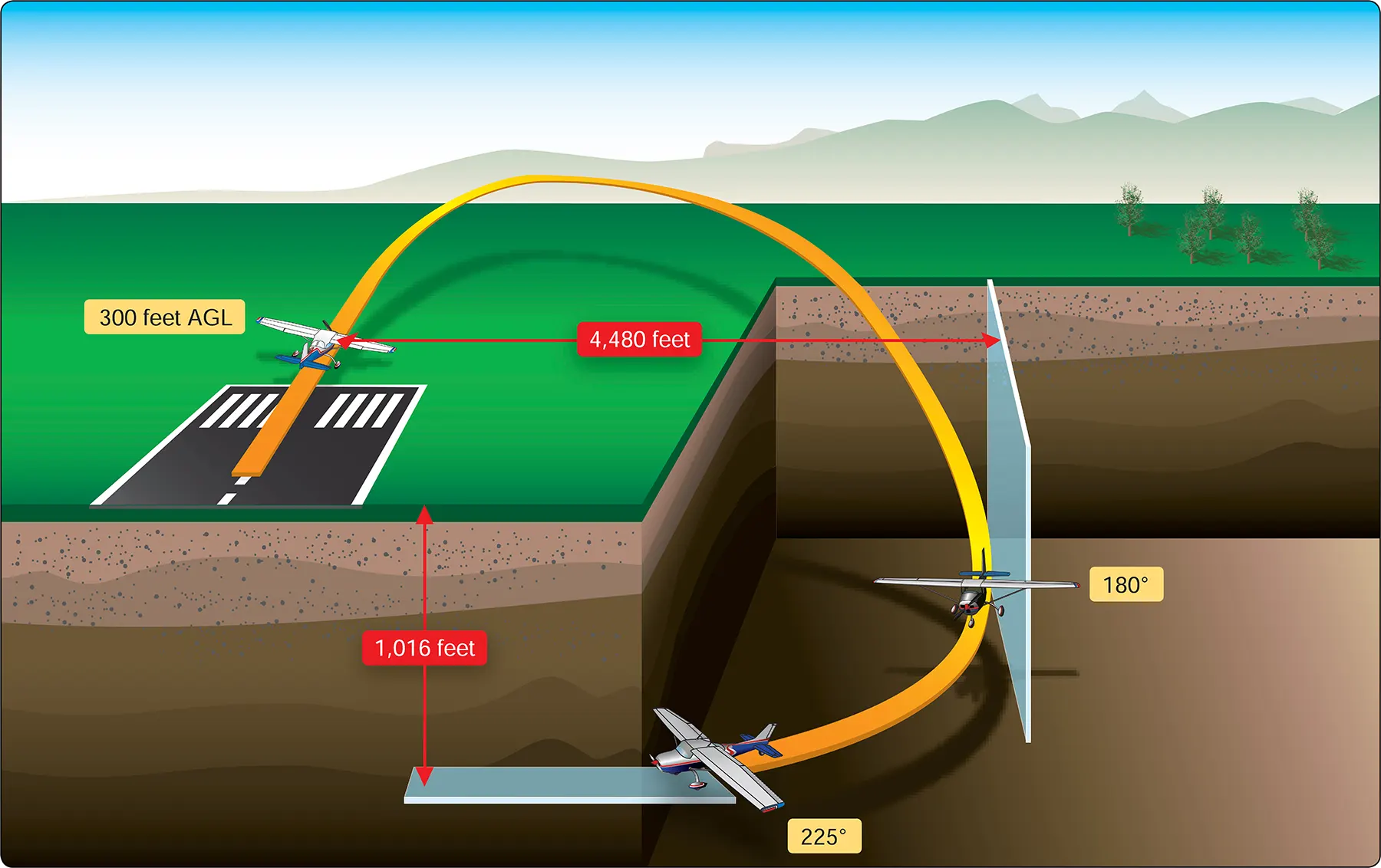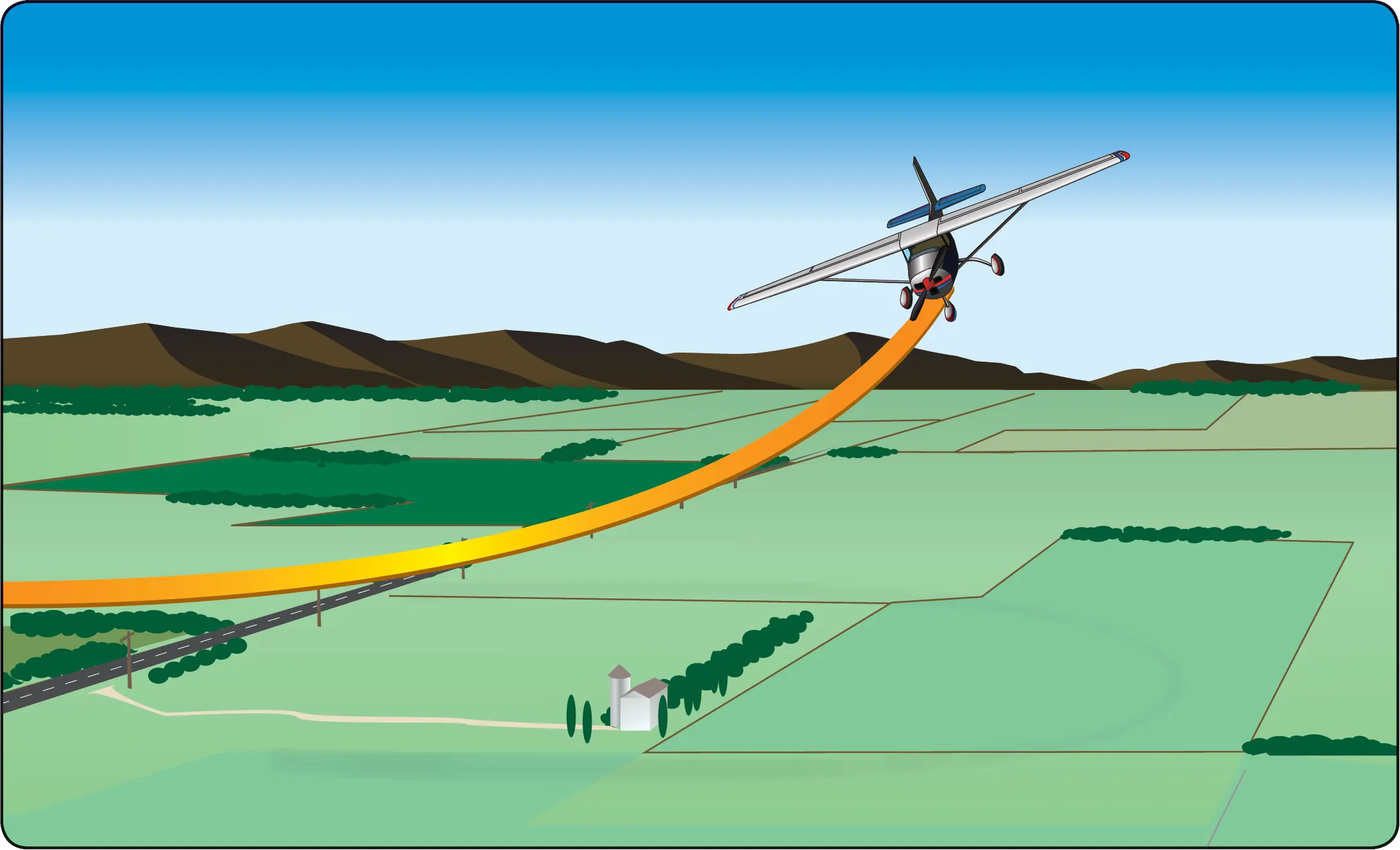Engine Failure After Takeoff (Single-Engine)
A number of variables and pilot actions factor into a successful emergency landing shortly after takeoff. When an engine failure occurs during the initial climb, the pilot should lower the nose of the airplane and establish the proper glide attitude. What happens next if the engine does not restart? Does the pilot select a field directly ahead (or slightly to the side of the takeoff path) or should the pilot turn back toward the point of departure? There’s not much time to decide and a lot to consider.
Continuing straight ahead or making a slight turn gives the pilot time to establish a safe landing attitude, and the landing occurs under control and as slowly as possible (assuming a takeoff made into a headwind). This minimizes the risk of injury and usually represents the option with the lowest risk—i.e. the safest option. Turning back requires a more complex analysis and consideration of risk. At some urban airports, there may be numerous hazards in the departure path. In that case, the pilot might turn back, but only if certain the airplane can reach the field from its current position and the pilot has trained and practiced the turn back maneuver.
Turning back to an airport after a low-altitude engine failure, also known as “the impossible turn,” presents many challenges, and a pilot who attempts to turn back without due consideration and training will need considerable luck to prevent disaster. If the airplane strikes the ground during the turn, cartwheeling could occur. If the pilot does not lower the nose sufficiently during the turn, an accelerated stall and fatal crash may occur. Even after executing a successful turn, a return to the airport often results in a downwind approach. The increased groundspeed could rush a pilot not properly trained for landing downwind. The increased groundspeed and associated increase in kinetic energy also raise the likelihood of serious injury if unable to make the field.
If considering a turn back to the runway following an engine failure on takeoff, the pilot should know the expected altitude loss during the turn for the specific make and model airplane as well as whether the airplane can physically glide back to the field after executing the turn. Traditionally, the FAA has given the following example. An airplane has taken off and climbed to an altitude of 300 feet above ground level (AGL) when the engine fails. [Figure 1]

After a typical 4-second reaction time, the pilot elects to turn back to the runway. Using a standard rate (3° change in direction per second) turn, it takes 1 minute to turn 180°. At a glide speed of 65 knots, the radius of the turn is 2,100 feet, so at the completion of the turn, the airplane is 4,200 feet to one side of the runway. The pilot needs to turn another 45° to head the airplane toward the runway. By this time, the total change in direction is 225° equating to 75 seconds plus the 4-second reaction time. If the airplane in a power-off glide descends at approximately 1,000 fpm, it has descended 1,316, feet placing it 1,016 feet below the runway.
The preceding example illustrates why a turn back, if attempted, requires a turn with a higher bank angle. A standard rate or shallow turn consumes too much time, requires too much distance, and generates an unacceptable solution.
Training for a turn back includes practicing turns in both directions at a safe altitude in the make and model flown after simulating an engine failure from a climb. Practice should result in consistent altitude loss and the ability to avoid an accelerated stall when executing a gliding steep turn. Pilots should be alert for and respond appropriately to any stall warning and reduce wing loading during the turn as necessary. There will be some observed variation in altitude loss during training. The pilot should anticipate that during an actual emergency, the expected altitude loss could end up at the high end of the range observed while practicing. Success in training involves the demonstrated ability to evaluate the effect of climb performance of the airplane, determine the better direction to turn back (usually into a crosswind), predict the altitude above ground after the turn, know the distance to the landing zone, and know if the glide performance of the airplane will allow the pilot to make the field. Some airplanes cannot usually make the return successfully, some can make the return under certain conditions, and some can usually return. The pilot should not attempt a turn back unless a successful turn back will result.
A turn back to the departure runway may require more than a 180° change in direction. There could also be cases where turning back results in overshooting the runway, and the pilot needs to sense the aiming point within seconds after completing a turn back and make any necessary adjustments to achieve the best possible outcome. A turn back at low altitudes presents an unacceptable risk for student pilots, low-time pilots, untrained pilots, pilots without adequate proficiency, and pilots flying airplanes with insufficient glide performance to return to the field. However, experienced pilots interested in knowing when and how to make an emergency turn back after takeoff should use the services of an authorized flight instructor who can explain and demonstrate the practicality (or impracticality) of “the impossible turn” in the specific make and model used during training.
Emergency Descents
An emergency descent is a maneuver for descending as rapidly as possible to a lower altitude or to the ground for an emergency landing. [Figure 2] The need for this maneuver may result from an uncontrollable fire, a sudden loss of cabin pressurization, or any other situation demanding an immediate and rapid descent. The objective is to descend the airplane as soon and as rapidly as possible while not exceeding any structural limitations of the airplane. Simulated emergency descents should be made in a turn to check for other air traffic below and to look around for a possible emergency landing area. A radio call announcing descent intentions may be appropriate to alert other aircraft in the area. When initiating the descent, a bank of approximately 30 to 45° should be established to maintain positive load factors (G forces) on the airplane.

Emergency descent training should be performed as recommended by the manufacturer, including the configuration and airspeeds. Except when prohibited by the manufacturer, the power should be reduced to idle, and the propeller control (if equipped) should be placed in the low pitch (or high revolutions per minute (rpm)) position. This allows the propeller to act as an aerodynamic brake to help prevent an excessive airspeed buildup during the descent. The landing gear and flaps should be extended as recommended by the manufacturer. This provides maximum drag so that the descent can be made as rapidly as possible, without excessive airspeed. The pilot should not allow the airplane’s airspeed to pass the never-exceed speed (VNE), the maximum landing gear extended speed (VLE), or the maximum flap extended speed (VFE), as applicable. In the case of an engine fire, a high airspeed descent could blow out the fire. However, the weakening of the airplane structure is a major concern and descent at low airspeed would place less stress on the airplane. If the descent is conducted in turbulent conditions, the pilot also needs to comply with the design maneuvering speed (VA) limitations. The descent should be made at the maximum allowable airspeed consistent with the procedure used. This provides increased drag and a high rate of descent. The recovery from an emergency descent should be initiated at a high enough altitude to ensure a safe recovery back to level flight or a precautionary landing.
When the descent is established and stabilized during training and practice, the descent should be terminated. In airplanes with piston engines, prolonged practice of emergency descents should be avoided to prevent excessive cooling of the engine cylinders.
